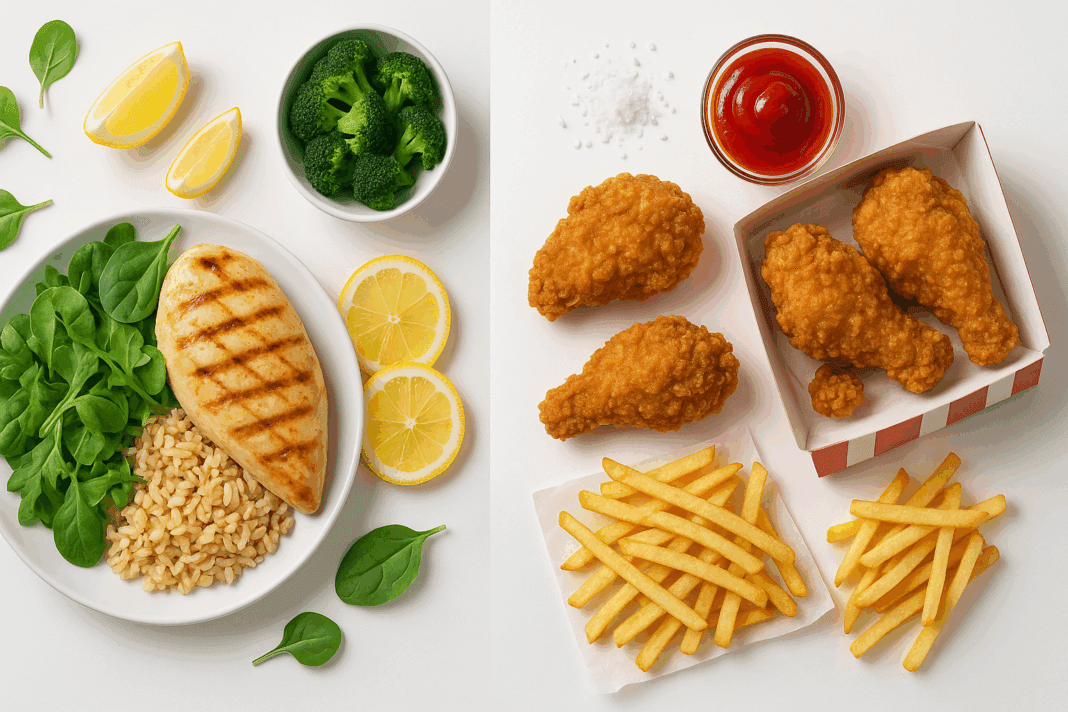Introduction: Why the Chicken Debate Matters in Heart Health and Recovery
For anyone focused on building endurance, improving performance, or recovering from a cardiac event, diet is a critical piece of the puzzle. Among the many foods debated for their cardiovascular impact, chicken is often spotlighted. Is chicken good for your heart, or can it pose hidden risks? It’s a question that resonates with athletes, health-conscious individuals, and patients with heart stents alike. Chicken is widely considered a lean protein option and a staple of many heart-healthy eating plans. But recent studies, combined with practical experience from cardiologists and nutrition experts, suggest that the answer depends on several factors—including preparation method, serving size, sodium content, and whether the poultry is processed or whole.
In this article, we explore the science behind chicken and heart health, while also looking at practical guidance for those recovering from cardiovascular procedures. Whether you’re asking “Is chicken bad for your heart?” or searching for answers about “heart stent foods to avoid,” understanding the bigger picture can help you make informed, effective choices for your long-term well-being.
You may also like: Smart Nutrition Choices for a Healthier Lifestyle: What to Know About Whole Grain Rice and Whole Wheat Rice
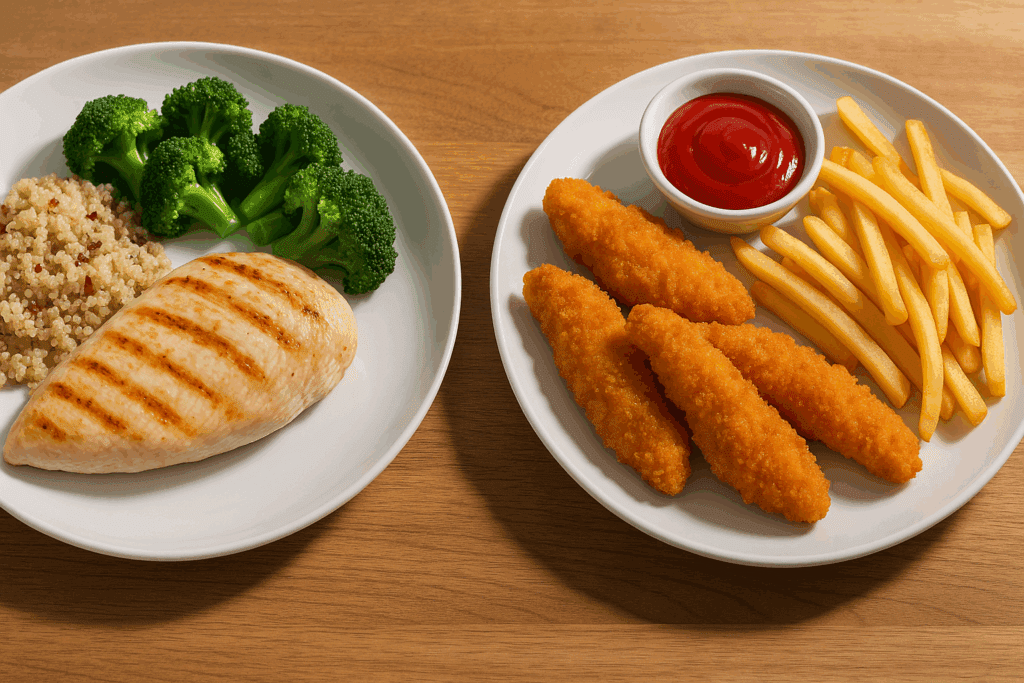
What Makes Chicken Seem Heart-Healthy—And Where the Nuance Lies
Skinless chicken breast, when prepared properly, is often praised for its lean protein content and low levels of saturated fat compared to red meat. It delivers essential nutrients such as vitamin B6, niacin, phosphorus, and selenium—all of which contribute to cellular health and energy metabolism. From a nutritional standpoint, chicken provides what the heart needs to maintain tissue repair, enzyme function, and blood vessel integrity. Especially for those engaged in stamina training, it serves as a convenient post-exercise recovery food that supports muscle regeneration without introducing excessive fats.
But the heart-healthy image of chicken begins to blur when we look closer at how it’s prepared and consumed. Fried chicken, for instance, contains trans fats and is often loaded with sodium—two key contributors to cardiovascular stress. Similarly, processed chicken products like deli slices and nuggets can undermine cardiovascular health due to their high levels of preservatives, hidden sugars, and salt. For people living with stents or a history of cardiovascular disease, such products fall under the category of heart stent foods to avoid.
Ultimately, the question of “Is chicken healthy for the heart?” hinges not just on the protein itself, but on how it fits into a broader diet and lifestyle. Clean cooking techniques, appropriate portions, and complementary sides all factor into whether chicken serves as a helpful tool—or a silent threat—in supporting heart health.
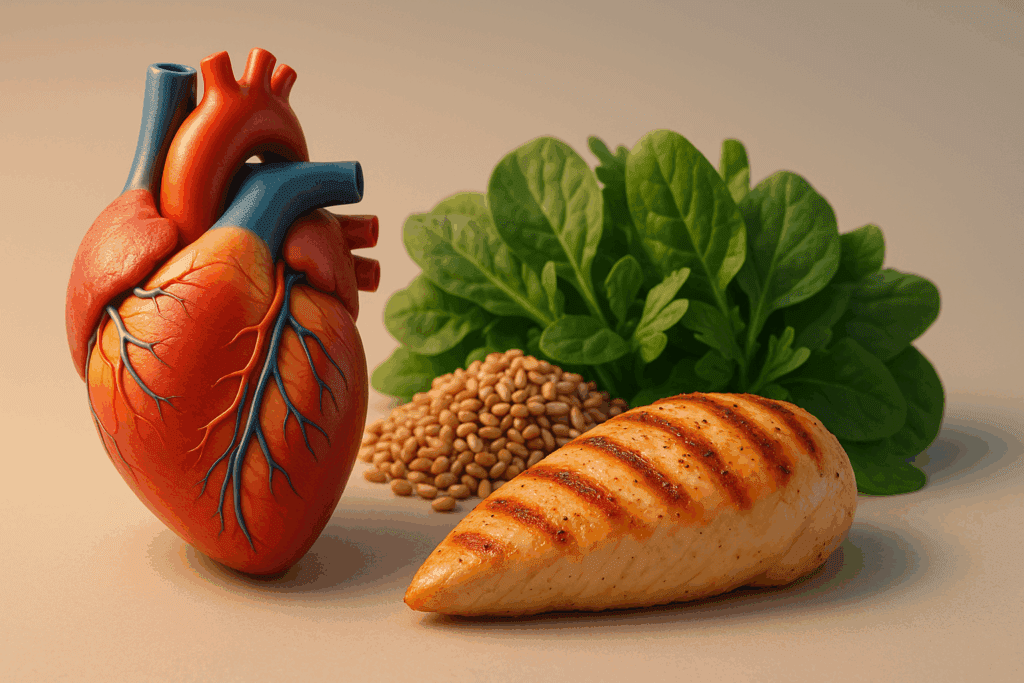
Is Chicken Good for Your Heart? Exploring What the Science Says
Recent research offers encouraging evidence for those who enjoy poultry. A study published in JAMA Internal Medicine revealed that substituting chicken for red or processed meats was associated with a lower incidence of cardiovascular events. The reason is simple: reducing saturated fat and increasing lean protein can improve lipid profiles and reduce inflammation. In moderation, grilled or baked chicken can support heart health, especially when paired with fiber-rich vegetables and whole grains.
Yet the story doesn’t end there. While unprocessed, skinless chicken may be helpful, the broader context of diet and lifestyle plays a pivotal role. Diets high in any animal protein—chicken included—may increase the body’s production of trimethylamine N-oxide (TMAO), a compound associated with atherosclerosis. This has led some researchers to caution against excessive intake of even white meats. That said, most experts agree that occasional chicken consumption, especially in balance with plant-based proteins, is perfectly reasonable—even for those with cardiac conditions.
So, is chicken good for your heart? Yes, when it’s lean, unprocessed, and well-prepared. But over-reliance on any one food source without variety can introduce risk. For people with stents, paying attention to the entire dietary landscape matters far more than focusing on a single ingredient.
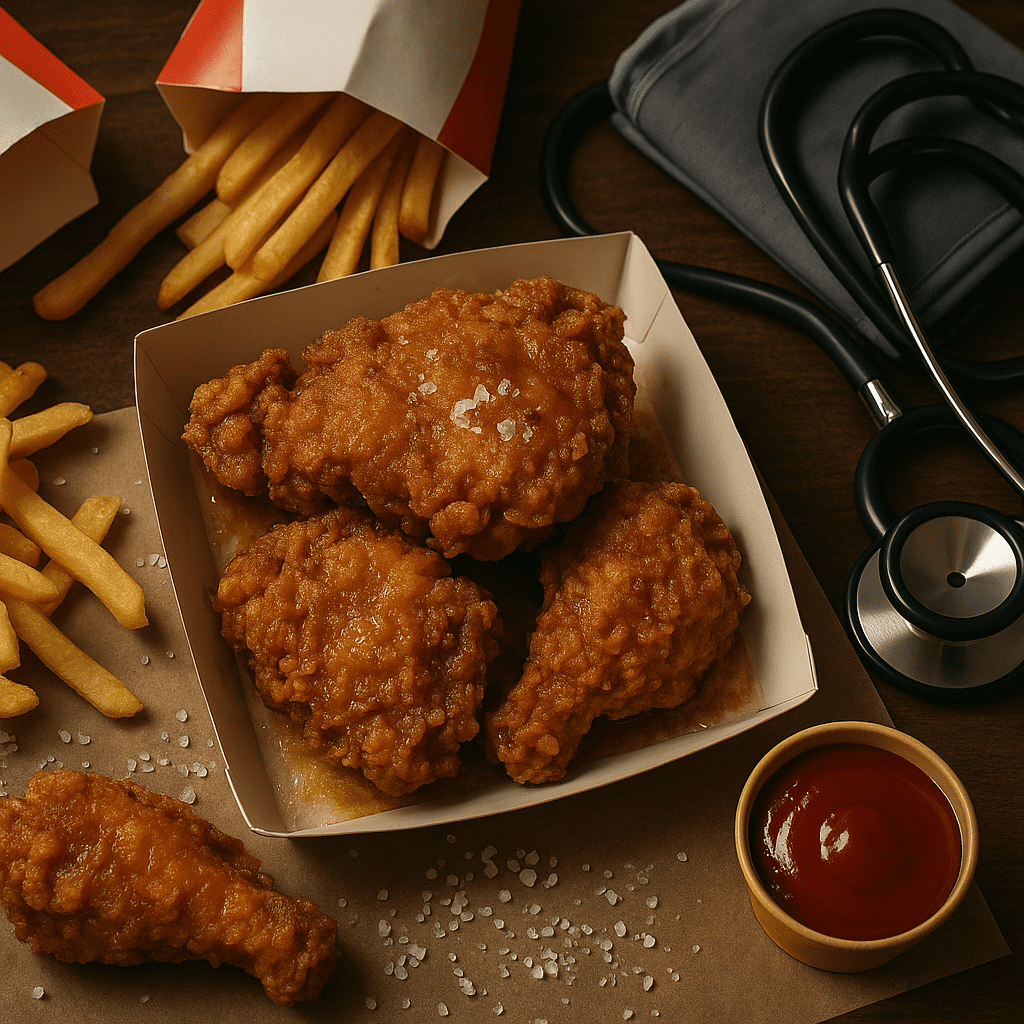
Is Chicken Bad for Your Heart? When Poultry Can Work Against You
While lean chicken can support heart health, it can also become problematic in certain forms. The most obvious culprit is fried chicken, which is often prepared in reused oils that introduce harmful trans fats into the body. These fats are known to elevate LDL (bad) cholesterol while lowering HDL (good) cholesterol—an especially dangerous combination for those already managing coronary artery disease. Fried chicken also tends to be calorie-dense and sodium-rich, further stressing the cardiovascular system.
Even grilled chicken isn’t always a safe bet, especially when it’s pre-seasoned or store-bought. Commercial marinades and spice blends often contain high amounts of salt and preservatives. If you’ve had a heart procedure like a stent placement, sodium becomes a top concern. Excessive salt intake can increase blood pressure, strain arterial walls, and elevate the risk of restenosis—the re-narrowing of the artery where the stent was placed.
This is why it’s critical for those recovering from a cardiac event to scrutinize not just whether they’re eating chicken, but what kind of chicken and how it’s prepared. If you’re asking, “Is chicken bad for your heart?” the real answer lies in how that chicken arrives on your plate.

Heart Stent Foods to Avoid: Why Chicken Isn’t Always Safe
Heart stents are life-saving devices, but they don’t fix heart disease—they merely manage its symptoms. After stent placement, your heart is still vulnerable to plaque buildup, clotting, and inflammation. That’s why dietary discipline is crucial, and knowing which foods to avoid can be just as important as knowing what to include. Among the top heart stent foods to avoid are those high in sodium, trans fats, and simple sugars—all of which can appear in certain chicken dishes.
Fried chicken, chicken nuggets, and heavily processed chicken lunch meats often rank among the worst offenders. These products are typically high in sodium, saturated fats, and artificial preservatives. Even skin-on chicken thigh meat, while natural, contains more saturated fat than the breast. Saturated fats have been linked to increased arterial stiffness and inflammation, both of which are major concerns for individuals with cardiovascular devices.
To support long-term stent success, choose chicken that is grilled or baked without heavy sauces. Season it with herbs instead of salt and avoid packaged or fast-food poultry entirely. It’s also wise to limit portion sizes to prevent excess cholesterol intake. Remember, a heart-healthy lifestyle is cumulative. It’s not about one meal—it’s about every meal adding up to a healthier future.

Optimizing Chicken for Athletic Performance and Cardiovascular Recovery
For athletes, chicken often serves as a cornerstone of performance nutrition. Its high protein content supports tissue repair and muscle maintenance, particularly during periods of intense training. But beyond just building muscle, chicken can also help protect the heart—if consumed wisely. Endurance athletes who incorporate skinless, organic chicken into a well-rounded diet rich in whole grains, fruits, and vegetables can enhance recovery, reduce inflammation, and maintain optimal cardiovascular function.
Cooking methods matter greatly. Marinating chicken with heart-protective ingredients such as olive oil, garlic, turmeric, or rosemary can help reduce oxidative stress. These ingredients have anti-inflammatory properties and can even lower blood pressure over time. For athletes or patients managing high cholesterol, using lemon juice or vinegar instead of creamy marinades can further support cardiovascular goals.
Yet even athletes aren’t exempt from dietary missteps. Relying too heavily on chicken, to the exclusion of omega-3-rich fish or plant-based proteins, can create nutritional gaps. Including salmon, lentils, tofu, and nuts alongside chicken helps round out the amino acid and fatty acid profiles essential for heart health. Whether you’re an elite runner or someone recovering from a heart procedure, chicken can be a valuable tool—but it must be used in concert with a broader, heart-supportive eating strategy.

Navigating Misinformation and Cultural Habits Around Chicken
Chicken’s health reputation has made it a go-to choice for people from all backgrounds, but not all chicken-based diets are created equal. In some cultures, chicken is served in creamy sauces or deep-fried in ghee, increasing saturated fat intake. In others, it may be slow-cooked with fresh vegetables and herbs—offering both flavor and health benefits. The way chicken is prepared in your home or community directly affects its heart-health profile.
Marketing buzzwords also create confusion. Labels like “natural,” “cage-free,” or “hormone-free” don’t always equate to better nutritional quality. Instead, focus on choosing chicken that is minimally processed, antibiotic-free, and ideally sourced from reputable farms that follow humane, sustainable practices. These decisions not only support ethical consumption but may also reduce exposure to harmful substances that can affect long-term health.
Educational outreach plays a major role in helping people make informed dietary choices. Cooking demonstrations, meal planning tips, and culturally sensitive nutritional counseling can help bridge the gap between tradition and cardiovascular science. Whether you’re cooking for yourself, your family, or your fitness team, understanding the nuances of chicken preparation makes a significant difference.
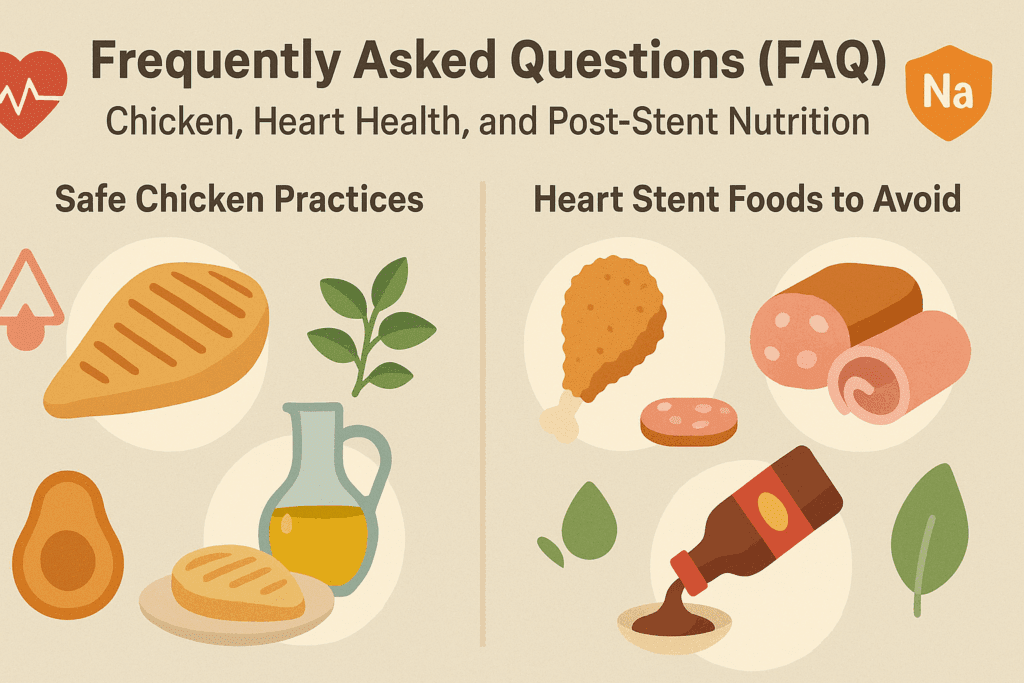
Frequently Asked Questions (FAQ): Chicken, Heart Health, and Post-Stent Nutrition
1. Can chicken be included in a Mediterranean-style heart diet after a stent procedure?
Yes, chicken can be incorporated into a Mediterranean-style diet even after a heart stent procedure—if it’s prepared thoughtfully. The Mediterranean diet emphasizes lean proteins, which can include skinless chicken breast, especially when it’s grilled or baked and paired with anti-inflammatory ingredients like olive oil, garlic, and herbs. While the focus of this diet is largely plant-based, including fish and legumes, occasional inclusion of poultry offers diversity and supports muscle maintenance during recovery. However, it’s essential to monitor sodium content in marinades or pre-seasoned chicken, as high-sodium items are considered heart stent foods to avoid. By combining lean poultry with fiber-rich sides and healthy fats, patients can enjoy chicken without compromising their cardiovascular goals.
2. Why do some experts suggest limiting chicken for heart health despite its lean profile?
Even though chicken is often considered lean, some experts urge caution due to the way chicken is commonly prepared and consumed. When evaluating whether chicken is healthy for the heart, it’s important to consider portion size, frequency, and preparation methods. Repeated exposure to high-temperature cooking methods, like charring or frying, can create compounds linked to inflammation and oxidative stress. Additionally, the overconsumption of animal protein—even lean types—can displace vital plant-based foods known to reduce heart disease risk. This nuanced perspective doesn’t suggest chicken is bad for your heart outright but emphasizes that moderation and context are essential.
3. Are certain chicken cuts better for heart health than others?
Yes, not all chicken cuts offer the same heart-health benefits. Skinless chicken breast is widely regarded as the best option due to its low saturated fat and high protein content. On the other hand, chicken thighs and wings contain more fat and are often associated with preparations that introduce trans fats and sodium—two things that can negatively impact cardiovascular health. For individuals concerned with whether chicken is good for your heart, choosing lighter cuts and avoiding the skin can make a meaningful difference. Also, organically raised, antibiotic-free chicken may reduce potential exposure to inflammatory compounds from commercial farming practices.
4. What types of chicken-based meals should be avoided after receiving a heart stent?
After a heart stent procedure, patients must be vigilant about limiting foods that increase cardiovascular risk. Processed chicken products—like breaded nuggets, chicken sausages, and deli meats—typically contain high sodium levels, making them top-tier heart stent foods to avoid. Fried chicken, even when made at home, often carries hidden calories and unhealthy fats that promote arterial inflammation. Restaurant chicken dishes may also pose a threat due to excessive salt and heavy sauces. Instead, opt for home-cooked meals using grilled chicken with herbs, lemon, and vegetables, allowing full control over ingredients and nutritional value.
5. Can chicken consumption affect cholesterol levels in people with heart disease?
Yes, it can. While lean chicken is lower in saturated fat than red meat, it still contains dietary cholesterol, particularly when consumed in large portions. Whether or not chicken is bad for your heart in this context depends heavily on the rest of your diet. If chicken meals are replacing higher-fat meats and are paired with vegetables and whole grains, they may improve lipid profiles. But if they’re heavily seasoned, fried, or consumed alongside refined carbs, they can elevate cholesterol and triglyceride levels. It’s best to combine chicken with soluble fiber sources like legumes, oats, or Brussels sprouts to promote optimal cholesterol balance.
6. Is chicken good for your heart if you’re also managing diabetes or metabolic syndrome?
For individuals managing diabetes or metabolic syndrome, chicken can be a helpful protein source—provided it’s not fried or processed. Blood sugar stability relies on meals that combine lean proteins with low-glycemic carbohydrates and ample fiber. Chicken breast can play a role here, especially when served with whole grains or non-starchy vegetables. That said, attention should also be paid to sodium and added sugars in sauces or spice blends, as these are often overlooked heart stent foods to avoid. Integrating chicken into a balanced plate may assist in glycemic control while also supporting cardiovascular resilience.
7. How do cultural food practices impact whether chicken is healthy for the heart?
Cultural cuisine plays a major role in determining if chicken is healthy for the heart or potentially harmful. In some regions, chicken is simmered with vegetables and lentils in light broths, creating nutrient-dense meals low in saturated fat and sodium. In others, it may be deep-fried or heavily salted, increasing cardiovascular strain. Understanding this context is important, especially when advising post-stent patients on dietary changes. Encouraging people to adapt traditional recipes—by baking instead of frying or using herbs instead of salt—can help preserve cultural identity while aligning with heart-health goals.
8. What emerging research might change our understanding of chicken and cardiovascular health?
Emerging research is beginning to explore the impact of chicken’s amino acid profile on gut microbiota and its downstream effects on cardiovascular health. Some studies are investigating how compounds produced during digestion, like trimethylamine N-oxide (TMAO), influence plaque buildup and heart disease risk. While much of this research has focused on red meat, chicken is also being studied for its potential role in modulating these metabolic byproducts. This does not mean that chicken is bad for your heart outright, but it does suggest a more complex relationship that may evolve as research deepens. Paying attention to cooking methods, sourcing, and meal composition will likely remain essential as new insights emerge.
9. How often is it safe to eat chicken if you’re trying to protect your heart long-term?
Moderation is key. For most people, eating chicken two to four times per week—preferably in lean, grilled form—can fit well into a heart-protective diet. If you’re asking, “Is chicken good for your heart?” the answer often lies in how frequently it replaces processed meats or accompanies vegetables and healthy fats. However, individuals with a history of cardiovascular events or stent placement should consult with a registered dietitian, as overconsumption of even lean meats may crowd out heart-protective plant-based foods. Tracking sodium, portion sizes, and total animal protein intake is crucial for maintaining long-term heart health.
10. Should chicken be completely eliminated from the diet after heart surgery or stent placement?
In most cases, there’s no need to eliminate chicken altogether—only to approach it with awareness and care. Chicken can be a safe, nutrient-rich option when it’s part of a whole-foods, plant-forward diet. After heart surgery or stent procedures, however, it’s critical to identify heart stent foods to avoid, which often include processed or fried chicken options. For optimal healing, lean cuts of chicken should be prepared without excess sodium and served alongside foods rich in antioxidants and fiber. With thoughtful preparation and portion control, chicken can support rather than hinder cardiovascular recovery.
Conclusion: Choosing Chicken Wisely to Support Heart Health and Performance
So, is chicken good for your heart? The most accurate answer is: it can be. When chosen with care, prepared with health in mind, and eaten in moderation, chicken can be a nourishing part of a cardiovascular-supportive lifestyle. It’s lean, high in protein, and—when grilled or baked—relatively low in saturated fat. For those in training, in recovery, or simply striving for better health, chicken can contribute to performance, endurance, and metabolic stability.
But not all chicken is created equal. Fried, processed, or overly salted chicken dishes belong on the list of heart stent foods to avoid. For patients with cardiovascular disease, the stakes are even higher. Chicken must be prepared in ways that align with medical guidance—low in sodium, free from trans fats, and ideally paired with fiber-rich plant foods.
Ultimately, the conversation isn’t just about poultry. It’s about patterns. It’s about asking not only “Is chicken good for your heart?” but “Am I creating a lifestyle that supports my heart every day?” With the right knowledge, support, and intention, chicken can become part of a diet that promotes not just survival, but thriving—one heart-healthy bite at a time.
Was this article helpful? Don’t let it stop with you. Share it right now with someone who needs to see it—whether it’s a friend, a colleague, or your whole network. And if staying ahead on this topic matters to you, subscribe to this publication for the most up-to-date information. You’ll get the latest insights delivered straight to you—no searching, no missing out.
Further Reading:
I’m a cardiovascular dietitian. Here are 7 things I eat and avoid for heart health
Foods That Are Bad for Your Heart
Poultry Consumption and Human Cardiometabolic Health-Related Outcomes: A Narrative Review

